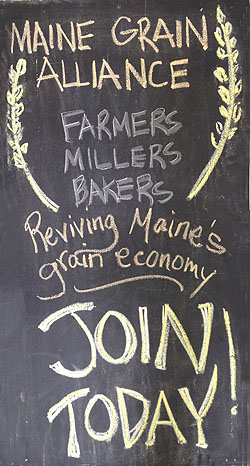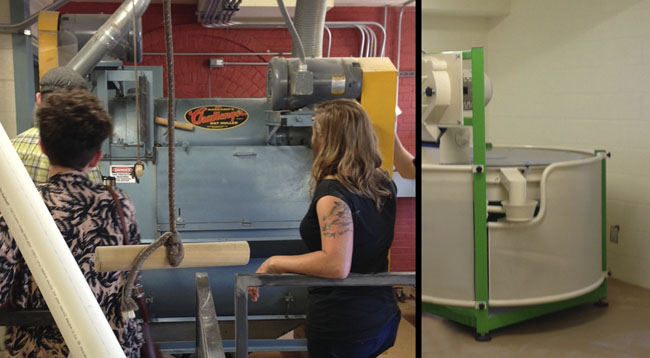Share This
Ten years ago, speech pathologist Amber Lambke hit on the idea of holding “The Kneading Conference” – a gathering of bakers and bread lovers – in an attempt to revitalize the small central Maine town of Skowhegan. Little did she know that volunteering to head up this local event would set her on an entirely new career path.
In the 19th century, Skowhegan was buzzing with activity from a paper mill, a saw mill, two flour mills, a wood pulp mill, three planing mills and a woolen mill. Fast forward to the 21st century, though, and the town had been largely hollowed out, with industry gone and a population of 9,000, half of whom qualify for SNAP (food stamps).
There are no lobsters or beaches – the usual Maine tourist draws – in Skowhegan, so Lambke had to come up with something different to attract visitors. Knowing that her town and the surrounding area served as the bread basket for much of New England until railroads began shipping in Midwestern wheat in the mid-1800s, Lambke settled on a festival to celebrate grains and bread.
The Kneading Conference quickly grew into an annual event, attracting artisan commercial bakers, home bakers, and grain farmers from around Maine and across the country for two days of hands-on workshops and a one-day Bread Fair. Lambke and her colleagues wanted to knit the grain community together year-round, however, not just three days a year. So in 2010, they founded the Maine Grains Alliance, a group dedicated to promoting “beneficial uses of grain for good health, food independence and purposeful jobs within viable communities.”
Soon, the old ways of producing food started coming back. Farmers began to grow wheat, corn, oats, and rye and sell the grains to bakeries in Maine. The bakeries however, generally wanted flour, not grain, limiting the market. Amber Lambke realized that the missing link in the grain chain was a local mill – so she decided to create the Somerset Grist Mill. We toured the mill with Lambke last weekend, and learned how she did this.
“This building used to be the jail,” she explains, as we stand outside a tidy brick building in the center of Skowhegan. It came on the market just as Lambke began looking for real estate to house her mill, and the sturdy structure, complete with commercial kitchen, seemed ideal. And the price was right: only $65,000. That was just the start; with renovations and equipment, the mill demanded an initial investment of $1,500,000.
Grain enters the mill in one-ton “tote bags” – about a dozen of them every two weeks, currently. Each tote bag equals the harvest of around one acre of grain. Ninety percent of the grain comes from Maine, while the rest is sourced from neighboring states to fill holes in the mill’s product line. Last year, the mill sold 360 tons of finished grains and flour; this year it’s on track to sell 700 tons.
Quality control is essential. Grain must be tested for moisture content of 13% or less – moist grain spoils quickly and attracts bugs – for fusarium, a fungus, and for field-sprouting. Here’s another missing link in the grain chain: there’s no grain lab in Maine, but fortunately the University of Maine has begun to do moisture and fusarium testing, and the University of Vermont can do Falling Number tests to see if uncontrolled sprouting has begun in the grains. To test functionality (protein and other factors that affect baking quality) Lambke must send samples off to a lab in Kansas.
Even good-quality grain must be cleaned as a first step. Equipment on the mill’s ground floor “screen cleans” the grain, removing sticks, chaff, and other debris, then sends it upstairs, where more cleaning happens in a vintage Clipper Seed Cleaner (left, above), clearly labeled “PAT. APR 8, 1924.” Lambke and her partner, baker Michael Scholz, bought the cleaner from an 80-something-year-old miller in Rhode Island after hearing through the grainvine that he had just what they needed. Although she describes the century-old machine as “a real workhorse,” she’s just about to install a brand new Clipper Seed Cleaner (center, above) to speed up production. A new Destoner (right, above) will also help remove small rocks mixed in with the grain.
When it’s time to mill, wheat flows into an Austrian Osttiroler mill, a beautiful wooden machine fitted with composite-material stones (shown above with Amber Lambke). “Getting the flour right is a very human process,” Lambke explains. “You grind some flour, then catch a little in your hand, flatten it, and feel the texture and particle size.” Big pails labeled “donation flour” catch these test batches, which are passed on to local schools or food banks. Once the miller is sure the stones are set, the mill starts running in earnest, making “noise about equal to a car engine.”
Once it’s milled, three kinds of flour are produced: 100% extraction (whole wheat), 86% extraction, and 75% extraction. For the latter two kinds of flour, a sifter – using different mesh screens – removes larger particles, creating flour with much or nearly all of the bran and germ removed. (Wheat averages about 80-83% endosperm, 2-3% germ, and the rest bran.) The flour is put into bulk bags for bakeries and foodservice – the largest part of the mill’s business – or into small retail bags for sale at Whole Foods, health food stores and to chefs at smaller restaurants. All bear the Maine Grain label. Their grains and flours can also be purchased on their website.
Some grains – oats, for instance – have an inedible hull that must be removed. They pass through a vintage oat-huller that got its start in Iowa in the 1930s. “Before chemical farming, farmers planted a cover crop of oats to keep down the weeds,” Lambke explains. “Soon there was a glut of oats, and someone discovered they’d make good hog feed, once they were hulled.” The old huller (left, below) breaks many of the groats, making them unfit for flaking, so Lambke has just purchased a new oat huller (right, below), which will result in a much higher yield of flake-ready oats.
Oats, in fact, comprise 40% of the mill’s business. “I did not plan on selling so many oats,” Lambke muses, shaking her head. “Oats are kind of a gateway grain for people; they’re familiar and easily understood.” While most rolled oats are steamed and then flattened into flakes, Somerset Grist Mill dry-flakes oats (without steaming), a difference that Lambke says results in a “sweeter, creamier taste and texture.”
Seeing all this equipment in this marvelous spotlessly-clean mill left me with one big question: How did Amber Lambke figure out how to do it, when she had no previous background in milling? She smiles matter-of-factly, as if anyone could duplicate what she’s done. “I went to K-State [Kansas State University] for a one week milling course, then hired the instructor as a consultant. He wasn’t sure what to make of our idea, but now he’s helped many small regional efforts. Then I went to Denmark to learn more, because I heard they were about ten years ahead of us in building a regional grain economy.” She stops and looks up, as if that explains everything. You listen, you talk to as many people as you can, you build a network of mentors, and the rest is easy (!).
Lambke’s most impressive creation, however, isn’t the physical mill – it’s the community she’s built at the same time. Aside from the Kneading Conference and the Maine Grains Alliance, Lambke uses extra space in the building for a gathering place for school kids to help each other with computers and other devices, and for a knitting shop frequented by many craftspeople in the area. (Yes, the knitters were the ones that slip-covered the railings on the back door of the mill building, at right.) There’s also a café – now being refurbished, since the Community Supported Agriculture (CSA) operation that shared the space grew too big and moved on. Everything, in Lambke’s world, is a vehicle for building community.
I left Skowhegan honored that I’d been invited to speak at the 10th annual Kneading Conference (more on that in a blog soon!) and inspired by what can happen in a community where people care and pull together. (Cynthia)
Want to learn more about building regional grain economies? Dr. Stephen Jones will be speaking on this topic at our upcoming conference, Whole Grains Away From Home, to be held September 25-27 in Chicago.








Add a Comment